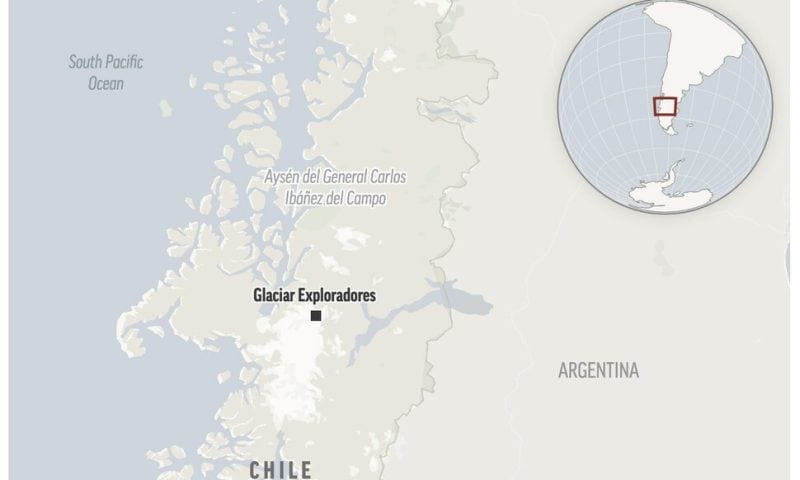Chile’s National Forestry Corporation has permanently closed a popular glacier, sparking outrage from adventurers and local guides
The decision by Chile’s National Forestry Corporation to permanently ban hikers from a popular glacier in Patagonia has incensed adventurers and local guides alike. What officials see as a question of safety — citing rapid, destabilizing melting — has sparked a debate over the risks of ice-climbing in a rapidly changing climate.
The Explorers, or Exploradores, glacier in Laguna San Rafael national park had been a well-trodden ice-hiking destination in the southern region of Aysén for at least two decades. But a two-week study by government hydrologists, found the glacier is reaching a dangerously unstable “inflection point.”
“There are evident risks and uncertainty regarding the behavior of the glacier,” the forestry department, which oversees Chile’s national parks, said in an email permanently banning ice-hiking on Oct. 31. “Conditions are not safe for ecotourism activities on the Explorers Glacier,” it read.
Ice-climbers around the world are being forced to adapt to the effects of warmer temperatures on well-known routes. Last July an apartment building-sized chunk of the Marmolada glacier in Italy’s Dolomite mountain collapsed onto a popular hiking route, killing 11 people. The same summer a number of agencies canceled ascents of Mont Blanc for the first time, as melting ice loosened an alarming number of rockfalls.
Nonetheless, the overnight closure of Explorers came as a shock to local guides.
Bianca Miranda has been leading expeditions on the glacier for over a decade and her local tourism company now faces the burden of refunding agencies who had booked up to March 2024.
The national park itself will remain open, and its 20,000 annual visitors will still be able to see the glacier by boat. For Miranda, however, the end of hiking Explorers is just personally painful.
“For us the closing is not only an economic blow but also an emotional one,” she said. “We have been working in this place for more than 10 years and it has become our second home.”
The study — and eventual closure of Explorers — came after a huge chunk of ice fell off, or calved, the main glacier on Oct. 6.
No hikers were harmed, and guides like Miranda have said the incident was normal for a constantly changing glacial landscape. The government’s study however suggests enormous fragmentation will soon become much more common.
The Explorers glacier has “thinned” 1.5 feet (0.5 meters) per year, according to drone images collected by government hydrologists since 2020. The number of meltwater lagoons sitting on top of the glacier has also doubled in that time. As the glacier’s overall surface contact with water increases — either where the glacier ends in Chileno valley or with its now 488 surface lakes — it melts more quickly.
Together, the report says, thinning and the exploding number of glacial lagoons are rushing Explorers to one of two possible outcomes.
Either a catastrophic amount of ice could calve off the main body of ice, or hundreds of small lagoons will cause the front of the glacier to “disintegrate.” In each case the report predicts Explorers will start a “rapid” retreat as melting accelerates.
Neither the report nor the closure notice mention climate change by name, but the former describes how the glacier had been relatively unchanged in almost a century until it began to experience speedy thinning in recent decades.
That’s a pattern consistent with glaciers around the world, as greenhouse gas emissions drive warmer ocean temperatures. One study this year predicted two-thirds of the world’s glaciers will have melted out of existence by the end of the century, rising sea levels 4.5 inches and displacing over 10 million people around the world.
Will Gadd is a Canadian guide and adventurer — the first person to climb a frozen Niagara Falls — who has watched the ice-clad world he loves fall apart around him.
“When I was a kid I thought glaciers were permanent, and so massive that nothing could affect them,” he said. “But now it’s becoming a real problem for us as guides. Imagine if you showed up at your office building and half of it was missing.”
Still, he said, closing routes permanently is not always the answer. “There’s probably some situations where that’s justified, but in general part of mountaineering and climbing is you have to make your own decisions.”
For Miranda, calculated danger has always been a part of exploring Laguna San Rafael National park. Like Gadd, access to her second home is on the line, as she and other guides try to negotiate a new entry route with authorities.
“We work in adventure tourism, where there is always an associated risk,” said Miranda. “If we’re going to close here, let’s stop climbing Everest, let’s stop climbing, stop skydiving.”

